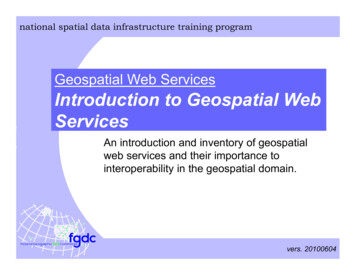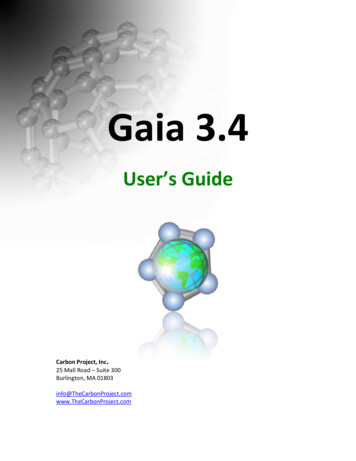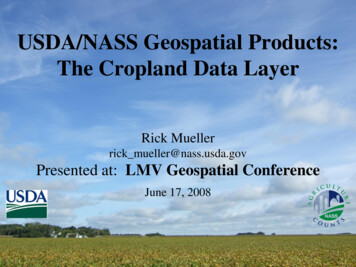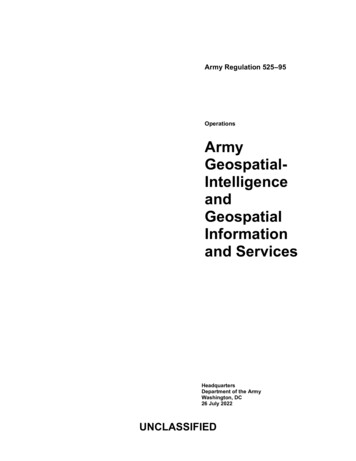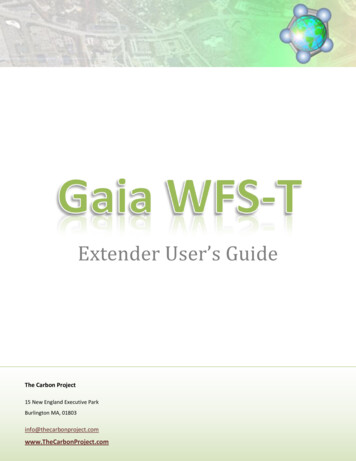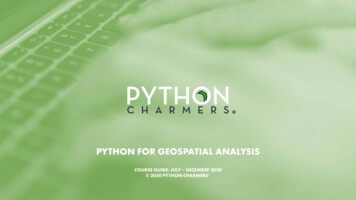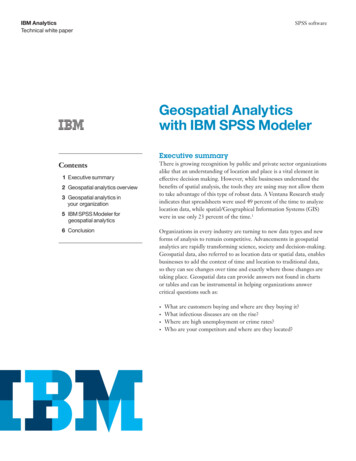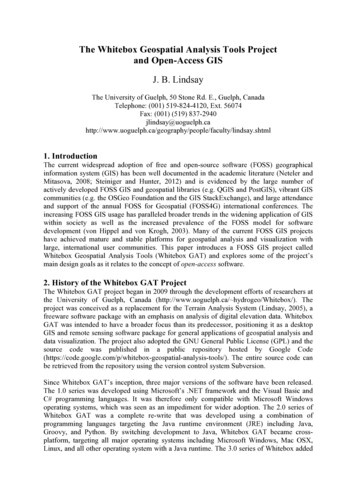
Transcription
The Whitebox Geospatial Analysis Tools Projectand Open-Access GISJ. B. LindsayThe University of Guelph, 50 Stone Rd. E., Guelph, CanadaTelephone: (001) 519-824-4120, Ext. 56074Fax: (001) (519) /geography/people/faculty/lindsay.shtml1. IntroductionThe current widespread adoption of free and open-source software (FOSS) geographicalinformation system (GIS) has been well documented in the academic literature (Neteler andMitasova, 2008; Steiniger and Hunter, 2012) and is evidenced by the large number ofactively developed FOSS GIS and geospatial libraries (e.g. QGIS and PostGIS), vibrant GIScommunities (e.g. the OSGeo Foundation and the GIS StackExchange), and large attendanceand support of the annual FOSS for Geospatial (FOSS4G) international conferences. Theincreasing FOSS GIS usage has paralleled broader trends in the widening application of GISwithin society as well as the increased prevalence of the FOSS model for softwaredevelopment (von Hippel and von Krogh, 2003). Many of the current FOSS GIS projectshave achieved mature and stable platforms for geospatial analysis and visualization withlarge, international user communities. This paper introduces a FOSS GIS project calledWhitebox Geospatial Analysis Tools (Whitebox GAT) and explores some of the project’smain design goals as it relates to the concept of open-access software.2. History of the Whitebox GAT ProjectThe Whitebox GAT project began in 2009 through the development efforts of researchers atthe University of Guelph, Canada (http://www.uoguelph.ca/ hydrogeo/Whitebox/). Theproject was conceived as a replacement for the Terrain Analysis System (Lindsay, 2005), afreeware software package with an emphasis on analysis of digital elevation data. WhiteboxGAT was intended to have a broader focus than its predecessor, positioning it as a desktopGIS and remote sensing software package for general applications of geospatial analysis anddata visualization. The project also adopted the GNU General Public License (GPL) and thesource code was published in a public repository hosted by Google -analysis-tools/). The entire source code canbe retrieved from the repository using the version control system Subversion.Since Whitebox GAT’s inception, three major versions of the software have been released.The 1.0 series was developed using Microsoft’s .NET framework and the Visual Basic andC# programming languages. It was therefore only compatible with Microsoft Windowsoperating systems, which was seen as an impediment for wider adoption. The 2.0 series ofWhitebox GAT was a complete re-write that was developed using a combination ofprogramming languages targeting the Java runtime environment (JRE) including Java,Groovy, and Python. By switching development to Java, Whitebox GAT became crossplatform, targeting all major operating systems including Microsoft Windows, Mac OSX,Linux, and all other operating system with a Java runtime. The 3.0 series of Whitebox added
enhanced vector data analysis support based on the Shapefile data format. The 3.0 releaseseries also featured significantly improved cartographic capabilities. Recently, efforts havebeen made to internationalize Whitebox GAT by translating much of the text that appears onthe user-interface into 11 languages. This task was accomplished through the contributions ofvolunteers drawn from the user community.3. Capabilities and DesignThe current version of Whitebox GAT contains over 360 plug-in tools for the analysis ofgeospatial data. These tools include a wide range of geospatial functions for performingtypical analysis tasks including vector overlay, distance analysis (e.g. buffering and costdistance analysis), terrain analysis, spatial hydrological processing (e.g. watershed andstream network extraction), raster algebra, geostatistical analysis (e.g. variogram modelfitting and kriging interpolation), and many other common GIS operations. A LiDAR toolboxcontains tools for working with and interpolating LAS files. For example, these tools can beused to create bare-Earth digital elevation models (DEMs) and canopy models from LiDARdatasets. There is also a Patch Shape Analysis toolbox that contains tools for characterizingthe shape and distribution of raster and vector polygon features. Additionally, WhiteboxGAT possesses significant image processing capabilities including tools for image filteringand enhancement, multi-spectral data analysis, classification, and change detection. From theoutset, Whitebox has been designed to process large raster data sets, recognizing the ongoing trend towards the application of increasingly extensive data coverage and finer imageresolutions. In a recent application, a 3.5 GB digital elevation model containing more thanone billion grid cells was successfully processed with Whitebox GAT to model surface flowpaths. Additionally, several tools in Whitebox GAT have been designed with algorithms thatperform parallel processing to improve the performance of long-running, computationallyintensive tasks.Whitebox GAT has been developed with an extensible design that allows users to integratecustom plug-ins that add new functionality. Plug-in tools can be developed using the Javaprogramming language or Whitebox’s built-in scripting capabilities. Supported scriptinglanguages include Python, Groovy, and Javascript. All of Whitebox’s plug-ins can be calledfrom scripts as a means of carrying out advanced geoprocessing workflows and taskautomation.Whitebox tools are contained within a familiar toolbox ‘treeview’ structure located in theside pane (Figure 1), a design that allows for easy integration of new plug-in tools andtoolboxes and the customization of functionality. Plug-in tools can also be accessed through auser search and a listing of recent and most-used plug-ins. This design for hosting toolspermits more advanced functionality to be presented to the user in a consistent and easilyaccessed manner that allows for simplification of the toolbar and menu structures. Toenhance the simplicity of the user interface design, the Whitebox GAT toolbar purposelycontains a minimum number of icons, all of which are used for manipulating maps and datalayers, vector digitizing, and standard or commonly accessed functionality (e.g. the rastercalculator). All plugins have simple dialog-box-style user interfaces with a set of commoncomponents for specifying the necessary parameters for running a tool. Dialog boxes have astandard design (Figure 2) with a panel on the left for inputting parameters and a right panelthat displays the help associated with the tool. A bottom pane contains buttons for runningthe tool, modifying and navigating the help documentation, and viewing the source of thetool. The View Code button is unique to Whitebox GAT and is central to the concept of open-
access software described below.Figure 1. The Whitebox GAT user interface.Figure 2. A typical tool dialog box including input parameters box, integrated help, andthe ‘View Code’ button that is central to the concept of open-access software.4. Whitebox GAT as Open-Access SoftwareWhitebox GAT derives its name from the concept of open-access software. Open access is
defined in the statement of the Budapest Open Access Initiative (Chan et al., 2002) as thepublication of scholarly literature in a format that removes financial, legal, and technicalaccess barriers to knowledge transfer. Although this original definition, and the subsequentBethesda Statement on Open Access Publishing (Suber et al., 2003), focussed solely on thepublication of research literature, we argue that the stated goals of reducing barriersassociated with knowledge transfer can be equally applied to software. Open-access softwarecan be viewed as a complimentary extension to the traditional open-source model of softwaredevelopment. All FOSS allow users the opportunity to download source-code, essentiallygiving users the ability to look inside the box. This is in contrast to proprietary software forwhich the user can only gain insight into the workings of a tool from the provided helpdocumentation. The philosophy of the Whitebox GAT project is that the geospatialcommunity as a whole benefits from the ability of users to examine the internal workings ofspecific algorithms or tools. Direct insight into the workings of algorithm design andimplementation allows for educational opportunities, i.e. knowledge transfer, as well as thepotential for innovation, improvements, and community-directed software development.Cȃmara and Fonseca (2007) recognized that adoption of open-source software is not only achoice of software, but also a means of acquiring knowledge. This is particularly important inthe GIS field because many geospatial algorithms are highly complex and are impacted byimplementation details. There are often multiple competing algorithms for accomplishing thesame task and the choice of one method over another can greatly impact the outcome of aspatial analysis operation.The concept of open-access software is based on the idea that software should be designed ina way that reduces the barriers that often discourage or disallow end-users from examiningthe algorithm design and implementation associated with specific geospatial tools. That is,open-access software encourages the educational opportunities gained by direct inspection ofcode. Cȃmara and Onsrud (2004) found that while some open-source GIS projects have largeuser-communities, most are developed by a relatively small number of individuals workingclosely in academic or commercial-sponsored settings. Thus, while many practitioners aretaking up open-source GIS because they are free and often analytically powerful alternativesto proprietary geospatial software, it does not appear that all of the benefits of the opensource model are being realized in many cases. It is likely that this finding reflects a set ofbarriers that discourages user engagement and is inherent in the typical implementation of theopen-source software model. An open-access software model, however, states that thereduction of these barriers should be a primary design goal that is taken into account at theinception of the project.The main barriers that restrict the average user of an open-source GIS from engaging withthe code include 1) the need to download source code from a project repository that isseparate from the main software artefact (i.e. the executable), the common approach used bymost open-source GIS projects, and 2) the required familiarity with the software structure.That is, an understanding of the organization of the source code is necessary to identify thecode associated with a specific tool or algorithm of interest. Most desktop GIS projectsconsist of hundreds of thousands of lines of computer code that are contained within manyhundreds of files. Large projects possess complex organizational structures that are onlyfamiliar to the core group of developers. The level of familiarity with a project’s organizationthat is needed to navigate to the code associated with a particular feature or tool presents asignificant barrier to the casual end-user who may be interested in gaining a more in-depthunderstanding of how a specific feature operates. Additionally, project development isgenerally carried out by the core development team within a specialized software program
called an integrated development environment (IDE). Again, a casual GIS end-user that mayfind themselves interested in how a particular tool works is less likely to install thisadditional IDE software, presenting yet another barrier between the user and the source code.Whitebox GAT attempts to address these issues by allowing users to view the computer codeassociated with each plug-in directly from the tool's dialog. Thus, just as a detaileddescription of a tool's working is provided in the help documentation, which appears withinthe tool's dialog, so to can the user choose to view the actual algorithm implementationsimply by selecting the 'View Code' button on the dialog. This removes the need to downloadseparate, and often large, project source code files and it eliminates the requisite familiaritywith the project to identify the lines of code related to the operation of the tool of interest.Furthermore the tool’s code will appear within an embedded window that provides syntaxhighlighting to enhance the viewer’s ability to interpret the information. This model has thepotential to encourage further community involvement and feedback. Among the group ofusers that are comfortable with GIS programming and development, the ability to readilyview the code associated with a tool can allow rapid transfer of knowledge and best-practicesfor enhancing performance. This model also encourages more rapid development becausenew functionality can be added simply by modifying existing code. The 1.0 series ofWhitebox, developed using the .NET framework, had the ability to automatically translatecode written in one programming language into several other languages, thereby increasingthe potential for knowledge transfer. Unfortunately this feature could not be replicated whenthe project migrated to the Java platform although there are on-going efforts to implement asimilar feature.5. Usage and ApplicationsA survey was carried out to gain a basic census of Whitebox GAT usage. The surveyconsisted of 795 users who downloaded the software 1138 times over a 13-week periodstarting in December 2013. The survey excluded downloads originating from the Universityof Guelph (the institution in which Whitebox is developed), of which there were 109. Theanalysis revealed that Whitebox is being used in at least 77 countries with the mostwidespread application in North America and parts of Europe (Figure 3). There is moderateuptake of the software within South America (particularly Brazil), Asia, and Oceania. One ofthe most striking findings however was the relatively few downloads within much of Africaand the Arabian Peninsula compared with the rest of the world. It is difficult to speculate onthe cause for this observation based on the results of the survey alone. Nonetheless, it ispossible that the sparse use of Whitebox GAT within these regions could reflect difficultieswith Internet access or the lack of an edition of the software that has been translated in anappropriate language. There is currently no available Arabic version of Whitebox and thisrepresents an area of interest for future development. In addition to the geographical datacollected, the study also revealed that 82.4% of the downloads were from computers usingMicrosoft Windows as an operating system, 9.9% were based on Mac OS X, and 7.7% usedLinux. It is interesting to note that compared with the general population of computer users,this distribution has a substantially higher proportion of Linux based users, which likelyreflects the open-source nature of both Linux and Whitebox, as well as a slightly lowerproportion of Microsoft Windows users.Although Whitebox GAT is being used extensively in government organizations and theprivate sector (mainly consulting and resource management), it has found greatest applicationin academia both for education and research purposes. A review of academic literature
demonstrated that Whitebox GAT is being used in research applications involving theextraction of terrain parameters from DEM data (Cho et al., 2011; Lindsay and Seibert, 2013;Schwanghart and Scherler, 2014), soils mapping and erosion modelling (Gutiérrez et al.,2011; Omuto and Paron, 2011; Hales et al., 2012), wetlands research (Clare and Creed, 2013;Rampi et al., 2014), ecological studies (Poulos et al., 2012a, 2012b; Abdi, 2013), and forgeoprocessing (Cao and Ames 2011, 2012). Whitebox GAT is frequently used in thesestudies to perform DEM-based analysis, which likely reflects the fact that this functionality isparticularly well developed, owing to the projects origins in the Terrain Analysis System.Figure 3. Downloads of Whitebox GAT over a 13-week periodstarting December 15, 2013.6. ConclusionThis paper briefly introduced the open-source GIS Whitebox Geospatial Analysis Tools,highlighting some of its capabilities and design goals. One of the unique characteristics ofthis FOSS GIS is the ease with which users are able to interrogate the algorithms forindividual geoprocessing tools. It does so by attempting to remove or lessen some of thebarriers that are often imposed on typical users when they attempt to gain deeperunderstanding of how a specific tool operates. We argue that this innovative ‘open-access’software development model may encourage greater knowledge transfer to typical end-usersand lead to rapid innovation.7. AcknowledgementsFunding for this research project has been provided by a grant of the Natural Sciences andEngineering Research Council of Canada.8. ReferencesABDI, A. M., 2013, Integrating Open Access Geospatial Data to Map the Habitat Suitabilityof the Declining Corn Bunting (Miliaria calandra). ISPRS International Journal ofGeo-Information, 2(4), pp. 935–954.CȂMARA, G. and FONSECA, 2007, Information Policies and Open Source Software inDeveloping Countries, Journal of the American Society For Information Science andTechnology, 58(1): pp. 121–132.
CÂMARA, G., and ONSRUD, H., 2004, Open-source geographic information systemssoftware: Myths and realities. In J.M. Esanu & P.F. Uhlir (Eds.), Open access and thepublic domain in digital data and information for science: Proceedings of anInternational Symposium (pp. 127–133). Washington, DC: National ResearchCouncil, U.S. National Committee for CODATA.CAO, Y., and AMES, D. P., 2011, Development and Implementation of an ExtensibleInterface-Based Spatiotemporal Geoprocessing and Modeling Toolbox. In AmericanGeophysical Union (AGU) Fall Meeting Abstracts, 1, pp. 1447, abstract # IN23B1447.CAO, Y., and AMES, D. P., 2012, A Strategy for Integrating Open Source GIS Toolboxesfor Geoprocessing and Data Analysis. Proceedings of the InternationalEnvironmental Modelling and Software Society (iEMSs) 2012 International Congresson Environmental Modelling and Software Managing Resources of a Limited Planet,Sixth Biennial Meeting, Leipzig, Germany R. Seppelt, A.A. Voinov, S. Lange, D.Bankamp (Eds.).CHAN, L., CUPLINSKAS, D., EISEN, M., FRIEND, F., GENOVA, Y., GUÉDON, J. C.,HAGEMANN, M., HARNAD, S., JOHNSON, R., and KUPRYTE, R. (2002).Budapest open access initiative, HO, H. C., SLATTON, K. C., KREKELER, C. R., and CHEUNG, S., 2011, Morphologybased approaches for detecting stream channels from ALSM data. InternationalJournal of Remote Sensing, 32(24), pp. 9571–9597.CLARE, S., and CREED, I. F., 2013, Tracking wetland loss to improve evidence-basedwetland policy learning and decision making. Wetlands Ecology and Management,DOI: 10.1007/s11273-013-9326-2.GUTIÉRREZ, Á. G., CONTADOR, F. L., and SCHNABEL, S., 2011, Modeling soilproperties at a regional scale using GIS and Multivariate Adaptive RegressionSplines. In Geomorphometry 2011, edited by T. Hengl, I. S. Evans, J. P. Wilson andM. Gould, pp. 53–56, Redlands, CA.HALES, T. C., SCHARER, K. M., and WOOTEN, R. M., 2012, Southern Appalachianhillslope erosion rates measured by soil and detrital radiocarbon in hollows.Geomorphology, 138(1): pp. 121–129.LINDSAY, J. B., 2005, The Terrain Analysis System: A tool for hydro-geomorphicapplications. Hydrological Processes, 19(5): pp. 1123–1130.LINDSAY, J. B., and SEIBERT, J., 2013, Measuring the significance of a divide to localdrainage patterns. International Journal of Geographical Information Science, 27(7):pp. 1453–1468.NETELER, M., and MITASOVA, H., 2008, Open source GIS: A GRASS GIS approach,Berlin: Springer.OMUTO, T. C., and PARON, P., 2011, Improved spatial prediction of soil properties andsoil types combining semi-automated landform classification, geostatistics and mixedeffect modelling. In Geomorphometry 2011, edited by T. Hengl, I. S. Evans, J. P.Wilson and M. Gould, pp. 53–56. Redlands, CA.POULOS, H. M., CHERNOFF, B., FULLER, P. L., and BUTMAN, D., 2012a, Ensembleforecasting of potential habitat for three invasive fishes. Aquatic Invasions, 7(1): pp.59–72.POULOS, H. M., CHERNOFF, B., FULLER, P. L., and BUTMAN, D., 2012b, Mapping thepotential distribution of the invasive red shiner, Cyprinella lutrensis (Teleostei:Cyprinidae) across waterways of the conterminous United States. Aquatic Invasions,7(3): pp. 377–385.RAMPI, L. P., KNIGHT, J. F., and LENHART, C. F., 2014, Comparison of Flow Direction
Algorithms in the Application of the CTI for Mapping Wetlands in Minnesota.Wetlands, DOI: 10.1007/s13157-014-0517-2.SCHWANGHART, W., and SCHERLER, D., 2014, Short Communication: TopoToolbox 2–MATLAB-based software for topographic analysis and modeling in Earth surfacesciences. Earth Surface Dynamics, 2: pp. 1–7.STEINIGER, S. and HUNTER, A. J. S., 2012, The 2012 free and open source GIS softwaremap – A guide to facilitate research, development, and adoption, Computers,Environment and Urban Systems, 39, pp. 136–150.SUBER, P., BROWN, P.O., CABELL, D., CHAKRAVARTI, A., COHEN, B.,DELAMOTHE, T., EISEN, M., GRIVELL, L., GUÉDON, J. C., and HAWLEY, ,http://legacy.earlham.edu/ peters/fos/bethesda.htm.VON HIPPEL, E., and VON KROGH, G., 2003, Open Source Software and the “PrivateCollective” Innovation Model: Issues for Organization Science, OrganizationScience, 14:2, pp. 209–223.BiographyJohn Lindsay is an Associate Professor of Geography at the University of Guelph, Canada.His research areas include open-source GIS, algorithm design for spatial analysis, digitalterrain analysis, and spatial hydrogeomorphology.
project was conceived as a replacement for the Terrain Analysis System (Lindsay, 2005), a . The 1.0 series was developed using Microsoft's .NET framework and the Visual Basic and . targeting all major operating systems including Microsoft Windows, Mac OSX, Linux, and all other operating system with a Java runtime. The 3.0 series of .


